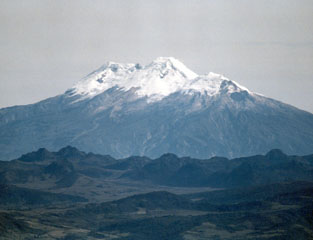Report on Nevado del Huila (Colombia) — 28 February-6 March 2007
Smithsonian Institution / US Geological Survey
Weekly Volcanic Activity Report, 28 February-6 March 2007
Managing Editor: Sally Sennert.
Please cite this report as:
Global Volcanism Program, 2007. Report on Nevado del Huila (Colombia) (Sennert, S, ed.). Weekly Volcanic Activity Report, 28 February-6 March 2007. Smithsonian Institution and US Geological Survey.
Nevado del Huila
Colombia
2.93°N, 76.03°W; summit elev. 5364 m
All times are local (unless otherwise noted)
The Washington VAAC reported that satellite imagery confirmed an eruption from Nevado del Huila on 19 February. The ash cloud rose to an altitude of 6.1 km (20,000 ft) a.s.l. and drifted W. Later the same day, a pilot reported an ash cloud to the same height and direction. During 2-3 March, INGEOMINAS reported that volcanic tremor was accompanied by gas-and-ash emissions that drifted NW. Fumaroles emitted from a N-S trending fissure.
Geological Summary. Nevado del Huila, the highest peak in the Colombian Andes, is an elongated N-S-trending volcanic chain mantled by a glacier icecap. The andesitic-dacitic volcano was constructed within a 10-km-wide caldera. Volcanism at Nevado del Huila has produced six volcanic cones whose ages in general migrated from south to north. The high point of the complex is Pico Central. Two glacier-free lava domes lie at the southern end of the volcanic complex. The first historical activity was an explosive eruption in the mid-16th century. Long-term, persistent steam columns had risen from Pico Central prior to the next eruption in 2007, when explosive activity was accompanied by damaging mudflows.
Sources: Washington Volcanic Ash Advisory Center (VAAC), Servicio Geológico Colombiano (SGC)

